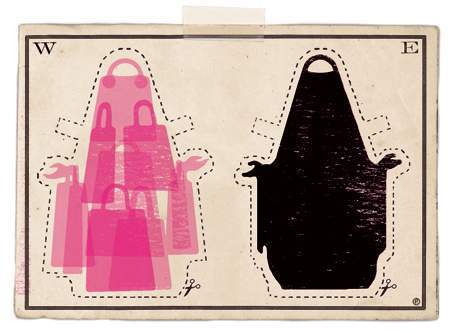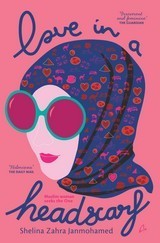Shelina Zahra Janmohamed's Blog, page 22
September 17, 2010
Support Love in a Headscarf and cast your vote
 Dear friends, and readers of spirit21,
Dear friends, and readers of spirit21,
Earlier this year, my book Love in a Headscarf was nominated as part of the Big Red Read, a book festival being held in London. Readers are encouraged to cast a vote for their favourite book from the nominations, and one will be declared the winner!
If you enjoyed Love in a Headscarf, I would ask you to show your support by sending your vote by email to: bigredreadvoting@redbridge.gov.uk. The deadline for votes is tomorrow, Saturday 18th September.
You can learn more about the festival, and see the other books that have been nominated, here. (although obviously I'd prefer you to vote for LIAH) 
September 14, 2010
The Pink Abaya Club, or, what is the colour of freedom
Belatedly, here is an article I wrote for The National.
One of the first decisions I made when I set up my blog about being a Muslim woman was that the colour black would be nowhere in sight.
In Britain, like many other European and American areas, black is the colour that typically defines Muslim women, a shorthand way of denoting our supposed anonymity and oppression, and a lazy way to instil fear and pity about us in equal measure.
It was time for people to see Muslim women as individuals, with their own personalities and stories, so, I chose the colour for my blog that was in my mind the furthest away from black – pink.

Illustration by Pep Montserrat, from The National
My mini-me, who welcomes readers to my website, is a small cartoon that looks a bit like I do, wears a pink headscarf with sparkly pink shoes, and has a cheeky smile. In her own small way she restores individuality and agency to the debate in the West about Muslim women.
I suggested a similar approach to some lovely Emirati women I met recently on a visit to the Gulf. They were dressed in gorgeous couture black abayas, which oozed sophistication and expense. Of course, in the Gulf, black has a totally different meaning for women. The black abaya is a symbol of all things womanly, and the best of Arabic culture.
The individuality of these successful professional women was obvious in the tiny embroidered details at the edges of their sleeves, the expensive crystals sprinkled across the black fabric and in the glimpses of the bold coloured lining as they glided elegantly around the room.
I was surprised that for women who clearly have had to be determined and focused to progress in the professional fields that they had chosen, in a society that is only now slowly accepting women into the workplace, when they stood together they all looked, well, the same.
I wondered if this was about creating organised power through a collective representation of women, or whether it was a cultural mechanism to keep women's individuality out of the public space, and turn this vibrant half of humanity into an undifferentiated anonymous mass.
Born of my own experiences in the West about the meaning that a simple piece of clothing like a headscarf and its colour can convey, I proposed to the women that they should form a Pink Abaya Club. It would be an invitation-only group, where a designer pink abaya would be worn on special occasions by women who had excelled in their field and who through their day-to-day lives were showing that women were part of the burgeoning, innovative culture that is emerging out of the Gulf.
The women were enchanted by this notion, and giggled initially with some excitement in their eyes about presenting themselves in a totally new way. It was a chance to offer their personalities to the outside world in a way that represented their vibrancy as individuals. And then abruptly they said: "But people will talk about us. They will say bad things because we are not wearing the black abaya."
It was clear from their words that the way to succeed as a woman was by keeping femininity and individuality to linings, crystals and sleeves, and blending into the social definition of acceptability for what it means to be a woman. The Pink Abaya Club was dead.
I returned to London, reflecting on my possibly irrational phobia of black. But, as a younger woman, I had had an equal distaste for pink, seeing it as too "girlie". What I am certain of is that I had deliberately used my pink headscarf as a political tool, with a small p. Of course, women have often used their clothing for political purposes. But I'm now beginning to wonder, am I only defying one stereotype of women to be caught by another?
In asserting my own "freedom" from black, is the colour pink as liberating for me in the West as I think it is? The colour pink in relation to the western world has a very narrow prescription for women, a hyper-feminisation that limits them to beauty and shopping, or the rather old-fashioned ideas of domesticity.
These are sold as liberating choices where women can be proud of their femininity and freedom, but do their narrow confines mean that they are just as limiting as the black lens through which Muslim women are seen? Is pink culture just as oppressive and anonymising?
There has been a recent revival in discussions about what it means to be a postmodern western woman. Are today's post-feminism women who have greater economic power – in itself a debatable point – and sexual liberation, now confined only to notions of shopping and beauty as markers of success?
The more we shop, and the more we adhere to standardised depictions of beauty, the better we are told we fulfil our function as women. The mantras that we follow are seemingly liberating, revelling in femininity: "You can never have enough shoes" (really?), and "Because you're worth it" (so buy this product).
Shopping and beauty are the two domains in which women are permitted to excel. It creates a strange conformity, with the only individuality that is permitted being in the detail and in the degree of being a woman in this hyper-feminine way. It's all on the edges: what is your hair like, which brand of shoe do you buy, how big are your breasts.
Just like the gorgeous and feisty abaya-wearing women of the Gulf, individual expressions of the personality of women and their characteristics as human beings are confined to the fringes.
This is "pink culture" where Cheryl Cole becomes Britain's sweetheart through her manufactured perfection, spending £200,000 every year on clothes and beauty; and where the glamour model Katie Price is considered a role model by teenage girls. Price has even just announced a make-up range for children.
I was given most food for thought while caught in this trap of negotiating my way between contrasting stereotypes of how to be a woman when I came across a campaign called Pink Stinks. The founders say: "We have always wanted to offer girls an alternative to all this 'princess sparkle make-up body-image popstar fantasy world'.
"We believe that body image obsession is starting younger and younger, and that the seeds are sown during the pink stage, as young girls are taught the boundaries within which they will grow up, as well as narrow and damaging messages about what it is to be a girl."
One of their aims is: "To challenge the 'culture of pink' which is based on beauty over brains and to provide an alternative." Being a woman and having a brain, or being a bit different, demonstrating that as a woman you've exercised your own choices are of course threatening. Culture says it is much safer and much more appropriate to stay within the acceptable boundaries of being pink.
Does my pink headscarf play into this notion of "girliness"? A headscarf and associated modest dress is upsetting and even threatening because it is not typically womanly. How will you know if I'm a "proper" woman, if my feminine assets are hidden away? And worse still, some see the fact that I do not put luscious locks on display as inflammatory, as though it is their right that I display myself as a "proper" woman in the mould that has been cast for me.
My headscarf is a defiant expression of my choice to reject pink culture, and be a woman on my own terms. A woman who makes her own choice and flaunts it: that's scary.
So, perhaps the reason that my pink headscarf feels approachable, acceptable and reassuring is because it re-casts me into an understandable and "safe" depiction of a western woman, focused on being girlie, beautiful and conforming to accepted standards of femininity.
It is exactly for these same reasons – but in their mirror image – that the Pink Abaya Club is such a dangerous and inflammatory idea. It would be just as elegant, modest and beautiful as the black abaya, but it would step out of the acceptable limits of the expression of womanhood which have been determined by society.
It is the simple act of a woman choosing for herself a colour that she feels best represents her individuality – whether that is pink, purple, blue, green or yellow – that makes it outside of what is "acceptable" for a woman to wear.
Whether East or West, Muslim or not, a woman's personality is limited to being expressed only in the margins. Instead, we should be revelling in the individuality of women, not confining them to a monochromatic choice of either hyper-feminine pink culture, or collective black anonymity.
'Love in a Headscarf wows India' according to Wall Street Journal
As regular readers of this blog will know, LIAH was launched in India earlier in the summer. After reaching Number 2 in the Bestseller list, it seems the book is being even more widely noticed! The Wall Street Journal's India Real Time blog ran this story today. Talking of Amaryllis, the imprint of Manjul Publishing that launched with LIAH the story says:
seems the book is being even more widely noticed! The Wall Street Journal's India Real Time blog ran this story today. Talking of Amaryllis, the imprint of Manjul Publishing that launched with LIAH the story says:
"The imprint's been very lucky with its first book, the Indian edition of "Love in a Headscarf: A Muslim Woman's Search for the One," a memoir about her arranged marriage by North London-raised writer and blogger Shelina Zahra Janmohamed, which came out here in July."
The article also carries a Q&A with the Head of Publishing at Amaryllis who says that they picked the book for the launch title because it is: "a book that would make waves and would connect with readers of all ages [...] a sensitive, yet light read that addresses issues that trouble young women not just in India, but all over the world." and commented on its: "runaway acceptability by the readers."
You can read the full article here: http://blogs.wsj.com/indiarealtime/2010/09/14/love-in-a-headscarf-wows-india/
September 11, 2010
Eid, a time for self-improvement and spiritual renewal
This article was published in The Times yesterday. Although I celebrated Eid on Friday, some Muslims will have done so on Thursday or today, Saturday. I think of it as a super-sized 3 day celebration.
Today, millions of Muslims around the world will be rejoicing in the celebration of Eid al-Fitr, which comes after the month of Ramadan. For the past 30 days, Muslims have been fasting from sunrise to sunset, abstaining from food, drink, and all other physical intake, including smoking and sex.
So it should come as no surprise that the day which immediately follows the end of Ramadan is one of great joy and festivity. There is a simple but intense pleasure in the first breakfast, the fragrance of the first morning cup of coffee after a month of abstention, the sheer delight of taste, texture and liquid on the tongue, the feeling of a filled belly during daylight hours. It is understandably human to delight in these pleasures after the immense control that has been exercised for 30 days.
The pleasure is intertwined with sadness. Ramadan has past. Gone for another year is a special month that combines an intensity of divine connection with a passionate communal spirit. Hundreds or even thousands of people will have gathered each evening to break their fasts together, to pray together, or simply enjoy a rich and supportive sense of togetherness which we in modern times in particular have lost.
For 30 days, the pull of the worldly, the carnal and even the mundane was severed, and the lightening of the consumerist load has created a sense of liberation. In this paradigm of Ramadan and the Eid that follows it, it should be noted that Eid is not the last day of the sacred month, but the first day of life after it.
At first glance Eid is a celebration because of the return to normality and the simple pleasures that have been denied. However, its true worth and festivity is rooted in the fact that those who have risen to the spiritual challenge of Ramadan — to become better people, better connected to the divine — begin their lives cleansed and anew. It might sound paradoxical to one who has not experienced fasting during Ramadan, but although the body feels tired by the end, the spirit feels renewed and invigorated. Islamic tradition indicates that the one who has successfully fasted begins a new and purified life on Eid.
That is why Eid is marked with the morning prayer, and the mandatory giving of charity, known as 'zakat ul fitr'. This year, the thoughts of many Muslims will turn to the victims of the floods in Pakistan, no doubt. I suppose "begin as you mean to go on" is an apt description of these rituals.
In fact, this idea of self-improvement is embedded in the ethos of Eid. Although Eid al-Fitr is one of the two officially marked festival days in the Islamic calendar — the other being the Eid of Hajj — the notion of Eid as a day of celebration has a wider meaning. The Prophet Muhammad talks of Eid as any day on which a human being has been a better person than the day before.
This year, Eid al-Fitr falls close to Rosh Hashanah, the Jewish new year, as well as during the season of "back to school". All of them celebrate rebirth, renewal and new beginnings. Despite school terms being something of the misty past for me, September still brings a sense of excitement and trepidation of what the future holds. Eid al-Fitr ushers in a similar feeling of anticipation, delight and hope.
The chance to start again, brand new, with no physical or spiritual burdens, now that is the real celebration of Eid.
To all readers, Muslim, Jewish, back-to-schoolers or otherwise, joy and blessings to you, or as Muslims will say over the next few days: Eid Mubarak.
September 9, 2010
Eid Mubarak!
 Whether you are celebrating Eid on Thursday, Friday, Saturday or Sunday – may you have a blessed and joyful Eid. As for me, I'll be donning my glad rags and doing the hugging rounds tomorrow, Friday. But as regular readers will know, my philosophy is to super-size Eid – so it will be a 3 day celebration for me. Eid Mubarak!
Whether you are celebrating Eid on Thursday, Friday, Saturday or Sunday – may you have a blessed and joyful Eid. As for me, I'll be donning my glad rags and doing the hugging rounds tomorrow, Friday. But as regular readers will know, my philosophy is to super-size Eid – so it will be a 3 day celebration for me. Eid Mubarak!
Shelina Zahra Janmohamed's Blog
- Shelina Zahra Janmohamed's profile
- 175 followers



